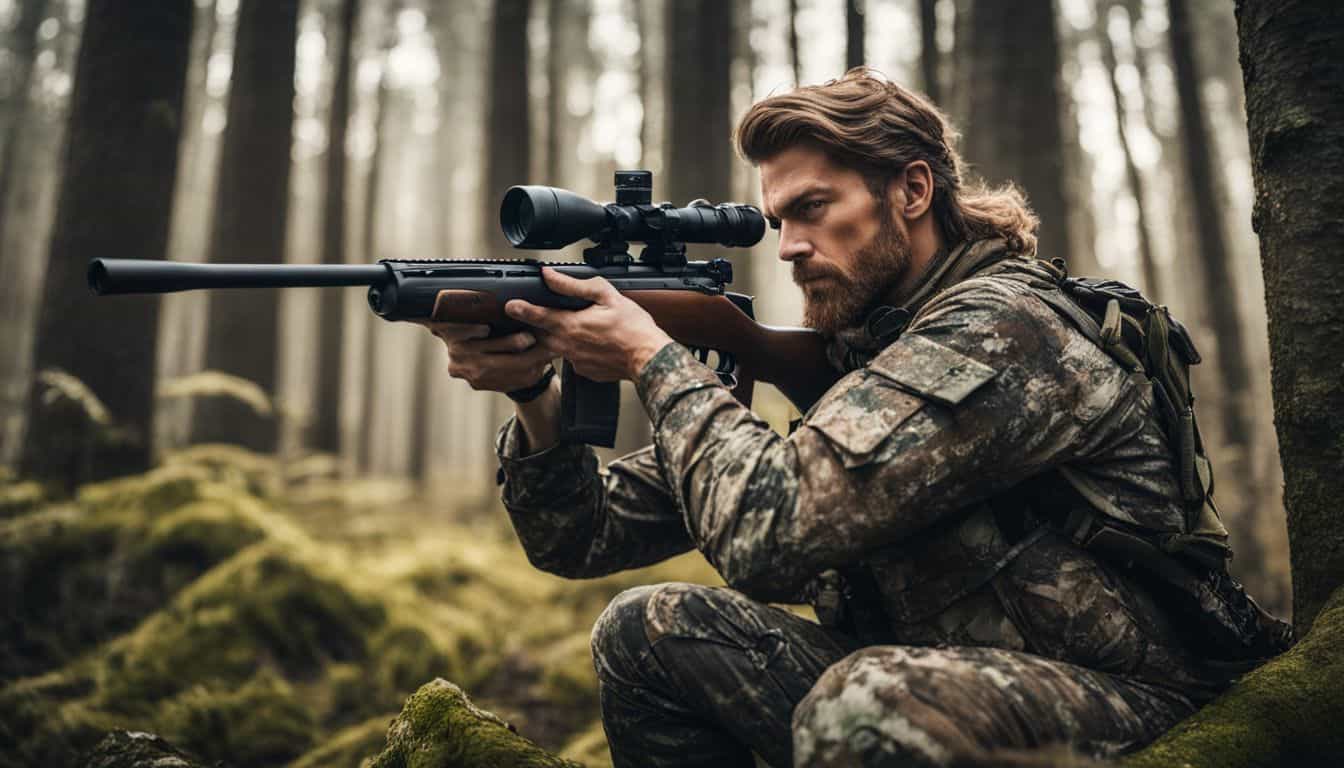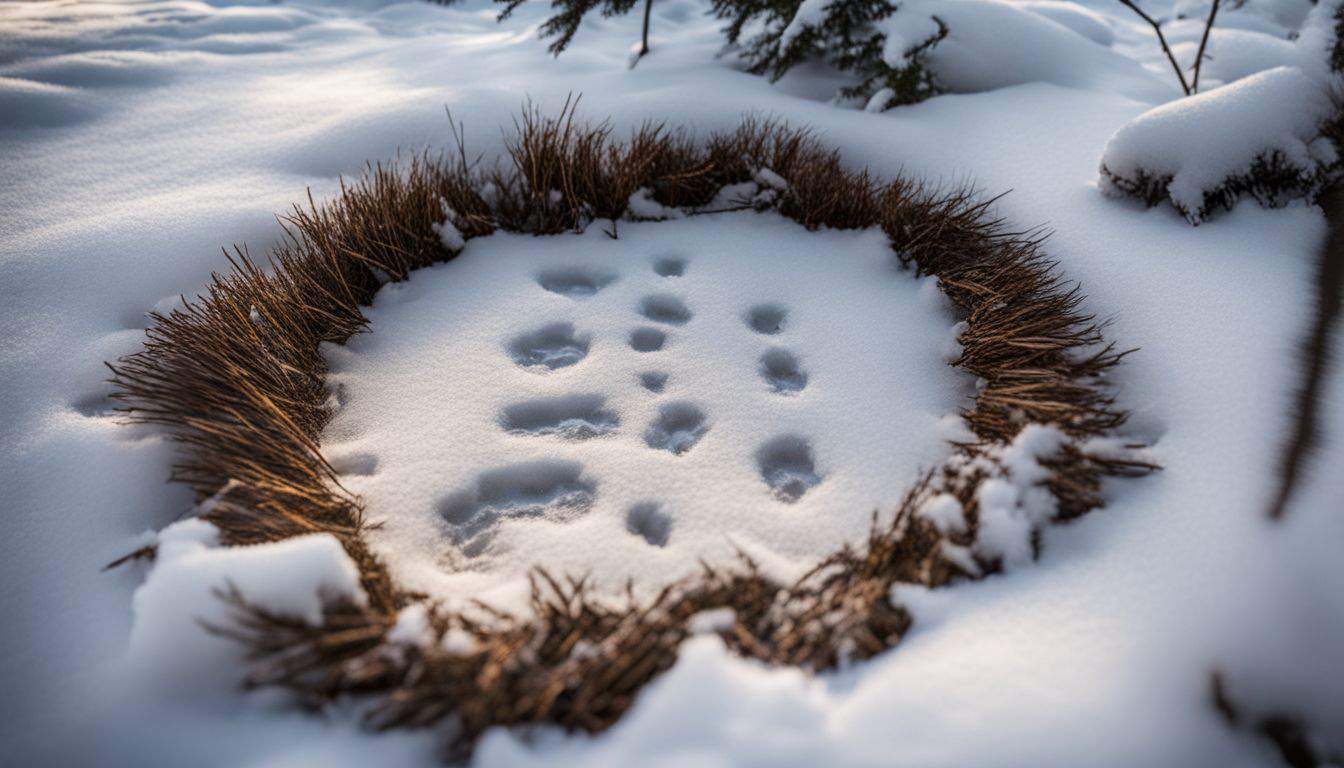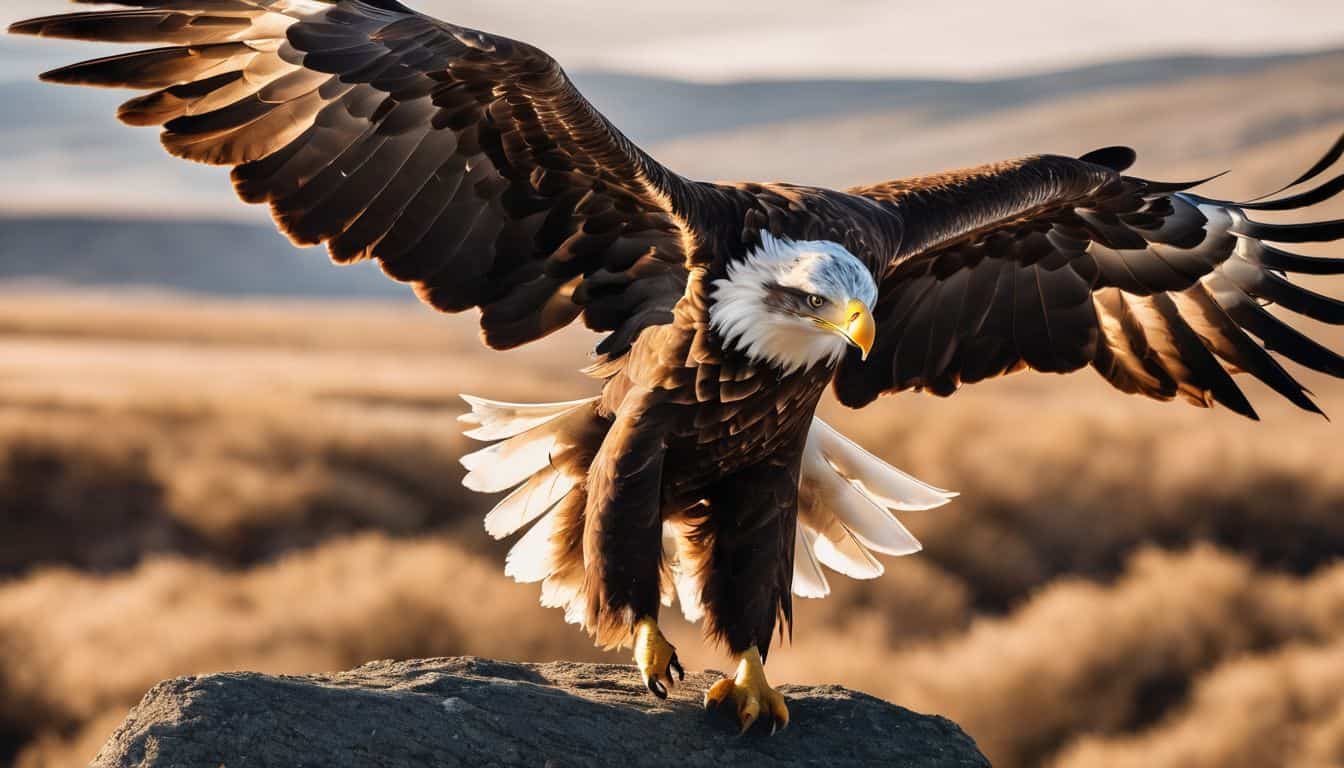Do you ever find yourself imagining being thrown unexpectedly into a survival situation, feeling a bit of unease about how to secure your next meal? Trust me, as an outdoor enthusiast and nature lover like myself, I’ve grappled with these same concerns.
It’s through embracing the art of hunting and trapping though, that I’ve found peace. This comprehensive yet simple guide will not only arm you with effective hunting and trapping strategies but also teach you to adeptly use modern tools, comprehend animal behavior patterns and maintain safety precautions while upholding ethical practices.
So are you ready to venture into these three key steps for achieving success in survival hunting? Let’s embark on this journey together!
Key Takeaways
- Hunting and trapping are important skills for survival, allowing you to obtain food, ensure self-sufficiency, and preserve resources in challenging environments.
- Understanding animal behavior, utilizing camouflage and stealth techniques, and identifying tracks and signs are key to successful hunting in survival situations.
- Setting up snares and traps is crucial for passive capture of animals while focusing on other tasks or resting. Choosing the right locations and using modern trapping tools can significantly increase your chances of success.
The Importance of Hunting and Trapping for Survival
Hunting and trapping are crucial skills for survival, providing a means to obtain food, ensure self-sufficiency, and preserve resources in a challenging environment.
Obtaining food in a survival situation
Getting food is a top concern in a survival spot. You must be smart and quick. Hunting small game can fill your belly. Trapping will also help you catch food while you rest or do other tasks.
Skills like hooking fish, picking edible plants, or trapping insects are important too. Tools like snares come in handy for these tasks as well. Cook all wild food well to kill any bad bugs that may make you sick.
Ensuring self-sufficiency
You can count on hunting and trapping to provide for your needs. It lets you get food and other supplies straight from nature. With just a few skills, anyone can hunt or trap animals for meat.
This way, you don’t need to buy food from the store so often.
Trapping also helps make money sometimes. You can sell fur from trapped animals. This fur is used in making clothes and pretty things to look at. So hunting and trapping not only feed you but also help save money or even earn it! That’s how they keep you self-sufficient!
Preserving resources
Busy hands save what is left. When you hunt and trap, you save food. You do not use too much at once. Hunting helps to keep animal numbers right. Too many of one kind can be bad for all animals in an area.
It’s like homework that keeps the class fair for everyone. Sustainable hunting makes sure there are enough animals for later too! So, we know it does good things for our land and its wild things by saving resources.
Basics of Hunting and Trapping for Survival
In hunting and trapping for survival, it is important to understand the basics. To begin with, you should know how to track animals and identify their signs. This includes learning about animal behavior and recognizing tracks or markings they leave behind.
Additionally, camouflage and stealth techniques can help you blend in with your surroundings while hunting or setting up traps. It’s also crucial to choose the right locations for trapping, as well as understanding animal habits and preferences.
By mastering these basic skills, you’ll be better equipped to procure food in a survival situation.
Effective Hunting Techniques
Mastering effective hunting techniques is crucial for successful survival in the wilderness. Understanding animal behavior, utilizing camouflage and stealth, and identifying tracks and signs are just a few key skills that can significantly increase your chances of securing food.
Read on to discover these essential techniques for hunting success.
Understanding animal behavior
Understanding animal behavior is a key aspect of successful hunting and trapping for survival. By observing and learning about the behaviors of different animals, we can increase our chances of locating them and capturing them effectively.
Factors such as predator features, timing, age classes, hunting conditions, and experience all play a role in determining the success of our hunting endeavors.
For example, understanding when certain animals are most active can help us plan our hunts accordingly. Some animals are more active during specific times of day or night, so knowing their patterns can give us an advantage.
Additionally, being aware of an animal’s preferred habitat and feeding habits can guide us in selecting suitable locations for hunting or setting up traps.
Furthermore, recognizing signs such as tracks and scat can provide valuable information about the presence and movement patterns of animals. By familiarizing ourselves with these signs and understanding how to interpret them correctly, we can better predict where animals might be located.
Using camouflage and stealth
Camouflage and stealth are key techniques that can greatly increase your chances of success in hunting and trapping. By blending in with your surroundings, you can become virtually invisible to animals, increasing the likelihood of getting close enough to make a catch. Here are some important things to keep in mind when using camouflage and stealth:
- Concealment: Use natural materials, such as branches, leaves, and mud, to create effective camouflage for yourself and your equipment.
- Disguise: Break up your outline by wearing patterned clothing or using natural coverings like grass or foliage.
- Invisibility: Choose colors that match the environment.you are in, whether it’s forest green, desert tan, or snow white.
- Blending in: Avoid sudden movements or anything that could give away your presence, such as loud noises or bright colors.
- Hiding: Find suitable hiding spots where you can observe animals without being seen, such as behind rocks or inside brush piles.
- Covert tactics: Move slowly and silently to avoid alerting nearby animals.to your location.
- Sneaking: Take small steps and place your feet carefully to minimize noise and avoid crunching leaves or snapping twigs.
- Shadowing: Use shadows to your advantage by staying low and moving along shaded areas where animals may be less likely to spot you.
- Ambush: Set yourself up in a concealed location near a known animal trail or feeding area, waiting patiently for the right moment to strike.
- Stalking: Practice patience and persistence, following animal tracks and signs while remaining mindful of wind direction and not alarming the prey.
Identifying tracks and signs
Tracking is an important skill when it comes to hunting and trapping for survival. By identifying tracks and signs left behind by animals, you can gather valuable information about their behavior and whereabouts.
Animal tracking involves looking for footprints, natural paths, nibbled plants, or other evidence of animal presence. This helps you understand the animals’ patterns and increases your chances of success in finding them.
With practice and observation, you can become skilled at recognizing different tracks and signs, which will greatly enhance your hunting abilities. Additionally, modern technology like animal tracking apps can be used to further improve your tracking skills.

Essential Trapping Methods
Setting up snares and traps is a crucial skill in hunting and trapping for survival, as it allows you to passively capture animals while you focus on other tasks or rest.
Setting up snares and traps
Setting up snares and traps is a crucial skill for survival hunting and trapping. Here are some important things to remember:
- Choose the right location: Look for signs of animal activity, such as tracks, droppings, or food sources. Setting your snares and traps in these areas increases your chances of success.
- Use the right materials: Depending on the size of the animal you’re targeting, use wire or paracord to construct your snares. Make sure they are strong enough to hold the animal securely.
- Learn different trap designs: There are various types of traps you can use, such as deadfall traps and twitch-up snares. Each has its own construction method and purpose, so study them carefully.
- Set multiple traps: Increasing your chances of catching an animal by setting up several traps at once. Place them along known animal trails or near their burrows or dens.
- Check your traps regularly: It’s important to regularly check your snares and traps to see if you’ve caught anything. This helps prevent animals from suffering unnecessarily if they become trapped.

Choosing the right locations
To maximize success in hunting and trapping for survival, it is crucial to choose the right locations. This means strategically positioning traps in areas where target species are likely to be found.
By selecting optimal trapping locations, we can increase our chances of catching the animals we need for sustenance and minimize the risk of capturing unwanted creatures. It’s important to use common sense and consider factors like animal habits, preferences, and track patterns when deciding where to set traps.
Additionally, using environment-specific traps designed for specific types of trapping can also improve our chances of success. Remember that choosing the right locations is key to ensuring a successful hunting and trapping experience.
Understanding animal habits and preferences
Understanding animal habits and preferences is crucial when it comes to successful trapping. By learning about how animals behave and what they prefer, we can increase our chances of setting effective traps.
Wildlife management experts use this knowledge to collect valuable information about wildlife, such as their feeding habits and preferred habitats. This helps in developing targeted trapping methods that are both humane and efficient.
By studying animal behavior, we can identify tracks and signs that indicate their presence, choose the right locations for our traps, and set them up in a way that appeals to the animals’ natural instincts.
Utilizing Modern Trapping Tools
Learn about the latest modern trapping equipment, select the right tools for different situations, and use technology to enhance your trapping success.
Learning about modern trapping equipment
When it comes to learning about modern trapping equipment, there are a few important things to keep in mind. First of all, using the right tools can greatly improve your success and efficiency as a trapper.
It’s essential to select the right traps for the animals you’re targeting and the environment you’ll be trapping in. There are many different types of traps available, such as foothold traps and body-gripping traps, each designed for specific purposes.
In addition to choosing the right traps, it’s also important to understand how they work and how to set them up properly. Trapper education courses and manuals provide valuable information on trap placement, trigger mechanisms, baiting techniques, and other essential skills.
It’s crucial to familiarize yourself with local trapping regulations as well.
Lastly, staying updated on advancements in modern trapping technology can give you an edge in your trapping endeavors. New innovations like trail cameras and electronic calls can help attract animals to your trap sites more effectively.
Technology has also led to improvements in trap design that prioritize the safety of trapped animals while still ensuring successful captures.
Selecting the right tools for different situations
Choosing the right tools for hunting and trapping is important to increase your chances of success in different situations. Here are some essential tools you should consider:
- Snare wire: Snare wire is lightweight, compact, and versatile. It can be used to set up snares for catching small game like rabbits or birds.
- Traps: There are different types of traps available, such as leg-hold traps, body-grip traps, and box traps. Each trap has its own advantages and is suitable for different animals and situations.
- Camouflage clothing: Wearing camouflage clothing helps you blend into the surroundings, making it harder for animals to detect your presence.
- Binoculars: Binoculars are useful for scouting and observing wildlife from a distance without alarming them.
- Hunting knife: A sharp hunting knife is an essential tool for field dressing and preparing game after a successful hunt.
- Fishing gear: In addition to hunting, having fishing gear like fishing line, hooks, and lures can provide an additional source of food if you come across a water source with fish.
Using technology to enhance trapping success
In today’s world, technology plays a big role in hunting and trapping for survival. It can greatly enhance our success in trapping animals. With advancements in technology, we now have tools like wildlife cameras that use artificial intelligence to survey different species of wildlife.
These cameras help us monitor animal activity and behavior, allowing us to choose the best locations for setting up traps. Additionally, trapper education programs provide valuable information about improvements in trapping equipment and methods.
By staying updated on these advancements and utilizing the right tools, we can increase our trapping efficiency and improve our chances of survival in the wilderness.
Safety Considerations in Hunting and Trapping
When it comes to hunting and trapping for survival, safety should always be a top priority. From handling firearms responsibly to avoiding dangerous animals, understanding these key considerations is crucial.
Read on to learn more about the essential safety practices you need to follow in order to have a successful hunting and trapping experience.
Handling firearms and other weapons
When handling firearms and other weapons during hunting and trapping for survival, it is crucial to prioritize safety. Always treat every firearm as if it is loaded, keeping in mind that accidents can happen even with unloaded weapons.
Control the muzzle of your firearm at all times, ensuring that it is pointed in a safe direction away from yourself and others. Remember not to touch the trigger until you are ready to shoot, maintaining proper trigger discipline.
Additionally, before taking any shot, be sure of your target and what is beyond it to avoid causing harm unintentionally. Following these precautions will help ensure a safe hunting and trapping experience.
Avoiding dangerous animals
In hunting and trapping, it’s important to avoid dangerous animals to stay safe. Animals like bears, venomous snakes, or wild boars can pose a threat if they feel threatened or cornered.
To minimize the risk of encounters with these animals, it’s crucial to be aware of your surroundings and follow safety guidelines. For example, making noise while moving through dense areas can alert animals to your presence and give them a chance to move away.
Additionally, keeping food stored properly and disposing of waste in designated areas helps prevent attracting wildlife. By being cautious and respectful of their space, we can reduce the likelihood of dangerous animal encounters during hunting and trapping activities.
Adhering to local hunting regulations
When it comes to hunting and trapping, it’s important to follow the local regulations. In Iowa, fur harvester education is not mandatory for hunting or trapping, but trappers have special rules that differ from hunting regulations.
If you’re in Iowa and want to learn more about responsible behavior and the laws surrounding fur harvesting, there are courses available that can provide valuable information. In Michigan, the state is divided into different hunting and trapping zones.
To hunt or trap in Michigan, you’ll need proof of completing a hunter safety class or having an apprentice license. It’s crucial to be aware of and adhere to these regulations to ensure both your own safety and the well-being of wildlife populations.
Survival Tips for Hunting and Trapping
Prepare for a hunting trip by packing essential gear, including a reliable firearm or bow, ammunition or arrows, field dressing tools, and navigation equipment.
Preparing for a hunting trip
Preparing for a hunting trip is crucial for a successful and safe experience. Here are some important steps to take:
- Educate yourself about the game and its environment: Learn about the animals you plan to hunt, their habitats, and their behaviors. This knowledge will help you understand where and when to find them.
- Obtain current state information and hunting regulations: Check local hunting regulations to ensure you are aware of any restrictions or special permits required. Stay updated on any changes in rules or seasons.
- Plan your hunting strategy: Create a detailed hunting plan that includes locations, dates, and specific targets. This will help you stay organized and increase your chances of success.
- Get the right gear: Make a checklist of essential hunting equipment such as firearms, ammunition, camouflage clothing, boots, binoculars, maps, and compasses. Ensure everything is in good working condition before heading out.
- Practice shooting skills: Regularly practice shooting with your firearm to improve accuracy and confidence. Familiarize yourself with different shooting positions and distances.
- Pack necessary supplies: Bring enough food, water, first aid kit, navigation tools, survival gear (like fire starters), extra clothing layers, and any other items needed for your safety and comfort during the trip.
- Inform someone about your plans: Before leaving for your hunting trip, let someone you trust know about your itinerary – where you are going and when you expect to return. This way, they can raise an alarm if something goes wrong.
Building effective shelters
Building effective shelters is crucial for survival in the wilderness. Here are some tips to help you create a safe and secure shelter:
- Find a suitable location: Look for an area that provides natural protection from the elements, such as trees or rock formations. Avoid low-lying areas prone to flooding.
- Use available resources: Utilize materials from your surroundings, such as branches, leaves, and rocks. These can be used to construct walls and a roof for your shelter.
- Consider insulation: Insulate your shelter by adding layers of leaves, moss, or grass between the walls and roof. This will help retain body heat and keep you warm during cold nights.
- Ensure stability: Make sure your shelter is stable and can withstand strong winds or heavy rainfall. Reinforce the structure with additional support if needed.
- Create a comfortable sleeping area: Clear the ground inside your shelter of sharp objects or rocks to make it more comfortable for sleeping. Use thick layers of vegetation or clothing as bedding.
- Maintain airflow: Leave openings in your shelter to allow for proper ventilation and reduce condensation inside.
- Prepare for emergencies: Keep emergency supplies like a whistle, flashlight, and first aid kit within reach inside your shelter.
Finding and purifying water sources
To survive in the wild, finding and purifying water sources is crucial. Here are some important things to know:
- Look for freshwater surface sources like streams, creeks, ponds, and lakes. These can provide you with clean drinking water.
- Distilling water is a great way to make it safe for consumption. This process involves boiling the water and collecting the steam, which will leave behind impurities.
- Purifying water in the wild helps eliminate harmful viruses and pathogens that can make you sick.
- Boiling water is one of the most efficient methods for purifying water when you’re out in the wilderness. It kills off any bacteria or parasites present.
- Remember to find and purify enough water to stay hydrated while in survival situations.
Utilizing All Parts of the Animal
Minimizing waste and maximizing resources is essential in survival hunting and trapping, which includes utilizing all parts of the animal such as reducing waste and maximizing resources, preparing and preserving meat, and utilizing animal hides and bones effectively.
Reducing waste and maximizing resources
When hunting and trapping for survival, it’s important to remember that utilizing all parts of the animal can help reduce waste and maximize resources. Every part of the animal can be used in some way, whether it’s for food, shelter, or tools.
By making use of everything, we minimize our impact on the environment and ensure that nothing goes to waste.
One way to do this is by preparing and preserving the meat properly. This not only ensures that we have enough food to sustain us but also reduces the chances of spoilage. Additionally, animal hides can be used for clothing or shelter, while bones can be turned into tools or weapons.
By using these resources efficiently, we are able to make the most out of every animal harvested.
It’s important to remember that reducing waste and maximizing resources is not just about personal gain – it also has a positive impact on wildlife conservation efforts. When we consume responsibly and avoid unnecessary waste, we lessen our demand for consumer products which in turn reduces pollution from manufacturing processes.
This helps protect wildlife habitats and preserves their natural balance.
Preparing and preserving meat
Preparing and preserving meat is an essential skill for survival enthusiasts like us. Here are some important tips to help you make the most of your hunting success:
- Butchering: Properly field dressing and butchering wild game ensures that the meat is safe for consumption. Remember to clean the animal thoroughly, removing any internal organs or glands that could taint the meat.
- Field dressing: When field dressing, it’s crucial to handle the meat with care and keep it as clean as possible. This helps prevent contamination and ensures a longer shelf life for your meat.
- Meat preservation: There are various methods you can use to preserve your hunted meat for extended storage. Smoking, salting, or dehydrating the meat are all effective ways to preserve it for later consumption.
- Extended storage: If you’re planning to store your meat for a long time, consider underwater caching. Evidence from ancient cache sites suggests that submerged storage can keep the meat fresh for months, even in warm climates.
Utilizing animal hides and bones
When using animal hides and bones for survival, there are several important ways to make the most of these valuable resources:
- Leather: Animal hides can be tanned and turned into leather, which can be used for making clothing, footwear, bags, and other useful items.
- Tanning methods: Brain tanning, bark tanning, and using salt are different methods that can be used to tan animal hides at home.
- Hide preservation: Properly preserving hides ensures that they stay in good condition and can be used for a long time.
- Animal byproducts: Aside from the hide, other parts of the animal like bones, sinew, teeth, and antlers can also be utilized for various purposes.
- Traditional hunting: Many indigenous cultures have long relied on hunting as a way of life. They have developed traditional techniques for utilizing all parts of an animal.
- Fur trapping: Trappers who hunt primarily for fur also utilize other parts of the animal to minimize waste.
- Wildlife conservation: Utilizing all parts of an animal supports sustainable resource utilization and helps to maintain the balance of ecosystems.
Practicing Respectful and Ethical Hunting
Understanding the importance of conservation and respecting the natural balance of ecosystems are crucial aspects of practicing respectful and ethical hunting. Learn how to adhere to these principles and enhance your hunting skills in a responsible way.
Read on to discover more about ethical hunting practices.
Understanding the importance of conservation
Conservation is really important when it comes to hunting and trapping. It means taking care of the wildlife and their habitats so they can continue to thrive for future generations.
When we practice ethical hunting, we help keep the balance in ecosystems by controlling overpopulation and protecting endangered species. By following regulations and sustainable practices, we can make sure there are always enough animals for us to hunt without causing harm to their populations or the environment they live in.
Conservation also involves preserving natural resources, like water and land, which are essential for wildlife survival. So when we understand the importance of conservation, we can enjoy hunting while also being responsible stewards of our natural world.
Respecting the natural balance of ecosystems
As a survival enthusiast, I understand the importance of respecting the natural balance of ecosystems while hunting and trapping. Conservation plays a crucial role in maintaining sustainability and ensuring the well-being of wildlife and their habitats.
By adhering to ethical hunting practices and responsible stewardship, we can contribute to wildlife management, preserve biodiversity, and protect ecological integrity. It is our responsibility as hunters to consider animal welfare, support habitat preservation efforts, and promote ecosystem resilience.
Adhering to ethical hunting practices
I believe that adhering to ethical hunting practices is incredibly important. It not only helps maintain public opinion but also ensures that hunting areas remain open for us to enjoy.
When we practice ethical hunting, we show respect for the game we hunt, follow the laws set in place, and meet the expectations of society. Additionally, by practicing good sportsmanship and supporting wildlife conservation efforts, we contribute to preserving our natural resources.
Remember, ethical hunting serves as a moral guide for us hunters to make the right choices in various situations. By doing so, we can be welcomed and accepted by society while also helping preserve our hunting traditions for generations to come.
Conclusion on Hunting and Trapping for Survival
In conclusion, hunting and trapping are vital skills for survival in the wilderness. By understanding animal behavior and using effective trapping methods, we can ensure a steady food supply and increase our chances of self-sufficiency.
Hunting and trapping also teach us respect for nature and the importance of conservation. So, embrace these skills to thrive in the wild!
FAQs on Hunting and Trapping for Survival
1. Is hunting and trapping necessary for survival?
Hunting and trapping can be necessary for survival in certain situations where access to food is limited.
2. What are the 3 ways to success in hunting and trapping?
The three ways to succeed in hunting and trapping for survival are having proper knowledge of animal behavior, using appropriate techniques and tools, and practicing patience.
3. Can anyone hunt or trap for survival?
Not everyone may have the skills or legal permission to hunt or trap animals, so it’s important to check local regulations and seek proper training before attempting these methods.
4. Are there any risks involved in hunting and trapping for survival?
Yes, there are risks involved, such as encountering dangerous animals, getting lost or injured during the process. It’s crucial to prioritize safety by being prepared with necessary equipment and staying aware of one’s surroundings.
5. How can I learn more about hunting and trapping for survival?
To learn more about hunting and trapping for survival, you can take courses from experienced hunters or trappers, read educational resources on the subject, or join local groups that promote outdoor skills education.





Leave a Reply